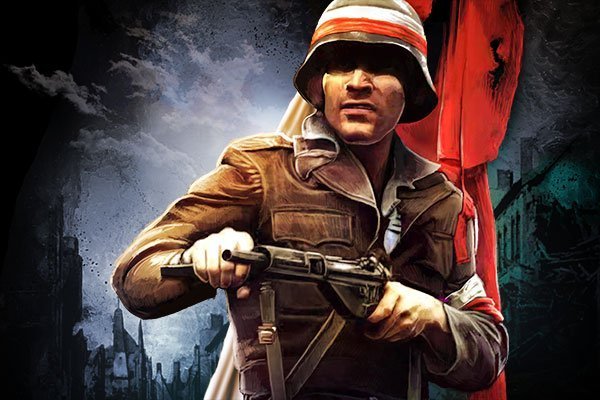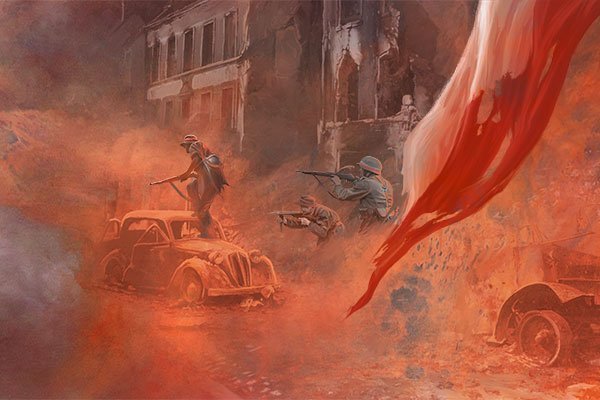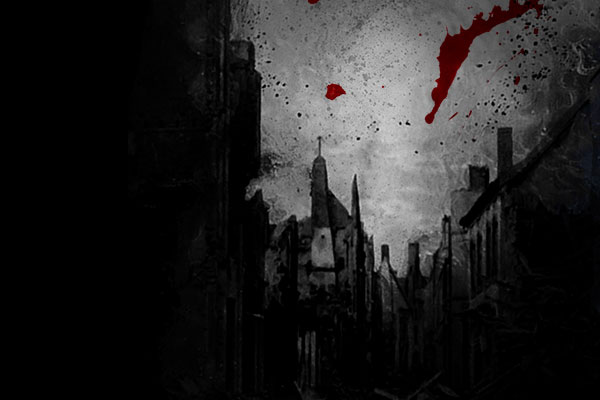The Warsaw Uprising
The Warsaw Uprising was one of World War II’s major insurrections and part of Akcja Burza – a series of anti-Nazi uprisings often referred to as Operation Tempest. Conducted by the Polish Home Army (Armia Krajowa), the riot aimed to throw off the shackles of the German occupation of Warsaw, but was finally oppressed 63 days after its outbreak.
In 1944 the already five-year-long occupation of the polish capital had left its mark on the city. Especially the Jewish inhabitants of Warsaw, as well as the intellectuals, suffered heavily under the cruel rule of the Nazi regime. But not before long a few first whispers of freedom began to roam through the streets of the city. Supported by the exiled Polish administration in London, the Polish Home Army tried to form the resistance against the oppressors, establishing its own social system for the oppressed. Plans were made to oust the Germans and regain the lost city.
The time has come
It was July 1944. The Eastern Front was in motion. The German Army Group Centre had collapsed in the face of repeated offensives by the Soviet First Belorussian Front. Now, striking deep into Poland, it was widely expected that capturing Warsaw would be next on the agenda for the Red Army.
 With the end of the German occupation on the horizon, the leaders of the Polish Underground Resistance, the Home Army, met for a secret meeting. After nearly five years of occupation, humiliation and suffering, the resistance of Warsaw was eager to rise up. Radio calls were made to the exiled Polish government in London, who in turn appealed to the British and American authorities for help, explaining that the time has come – the Poles would now fight to take back their capital.
With the end of the German occupation on the horizon, the leaders of the Polish Underground Resistance, the Home Army, met for a secret meeting. After nearly five years of occupation, humiliation and suffering, the resistance of Warsaw was eager to rise up. Radio calls were made to the exiled Polish government in London, who in turn appealed to the British and American authorities for help, explaining that the time has come – the Poles would now fight to take back their capital.
However, the Western Allies were hesitant to promise help. They welcomed resistance against the Germans, but there were logistical problems as the fight in France and Italy was in full swing, but mostly, this was the Soviet theatre of war, and they didn’t want to step on any toes. The Poles would therefore have to rely on Soviet cooperation first and foremost. However, the position of the Home Army towards the Soviet Union was one of uncertainty and mistrust, as memories of the pact between Hitler and Stalin that had swallowed and divided Poland were still fresh.
If the Poles didn’t act, then the Red Army would overrun Poland and the government in exile would be powerless in a newly communist Poland, but if the rising were to be successful, then Warsaw would be in the hands of democratic Poles. That would mean that the autocratic Soviet Union could not simply impose its will on Poland, so the Poles had everything to win and everything to lose.
However, the Germans still had strong forces in the region. If the resistance rose up before the Wehrmacht, the Germans would have most certainly crushed them, so the Polish Home Army had to wait for the last possible moment – when the Red Army would be on the outskirts of Warsaw. Then, with logistical help from the West and cooperation from the Red Army, the insurgents could drive the Germans out of the city. At least one of those two things had to happen, or the rising would be doomed.
Back in February, the resistance fighters outside of Warsaw had made contact with Soviet Marshal Rokossovsky’s spearheads. Rokossovsky agreed to ‘principal tactical cooperation’ but refrained from promising anything beyond that. And when the Home Army began revealing itself to the Soviets, they were greeted with unexpectedly hostile behaviour.
The available reports of the NKVD – the Soviet interior ministry and secret police – painted a clearer picture of the situation. They called the Polish Home Army ‘illegal formations’, ‘rebels’ and ‘bandits’. They were ‘White Poles’, allied to Great Britain, and were considered an old enemy. Even though they were fighting the same enemy at that point in time, Polish nationalism was contradictory to Stalin’s plans, and of course it had only been just over 20 years since the Poles won the Polish-Soviet War, and one of the people responsible for the loss of the Battle of Warsaw back then was Josef Stalin.
The NKVD made it clear that they would not allow any irregular or partisan action in the rear of their armies. Soon, any Polish resistance fighter caught behind the frontline would be arrested, disarmed and removed. By July, over 30,000 Home Army fighters had been interned by the Red Army.
Inside Warsaw, the Home Army was caught between the desire for action and the need for caution. The atmosphere in the city was tense, and Poles and Germans alike felt that something was about to happen. By August, the Soviet front drew close, and while the Wehrmacht prepared to halt Soviet attacks across the Vistula, the Home Army decided to risk everything.
The fight for Warsaw begins
 On the night of August 1, groups of armed young men broke curfew and gathered throughout the city. At 05:00, they struck. German trucks were bombed and German patrols gunned down. They stormed the railway office, the post office and the major power station. Most importantly, they captured storehouses, taking German helmets and weapons, camouflage jackets and even SS uniforms. To distinguish themselves from their enemy, they wore their white and red armbands or eagle insignias.
On the night of August 1, groups of armed young men broke curfew and gathered throughout the city. At 05:00, they struck. German trucks were bombed and German patrols gunned down. They stormed the railway office, the post office and the major power station. Most importantly, they captured storehouses, taking German helmets and weapons, camouflage jackets and even SS uniforms. To distinguish themselves from their enemy, they wore their white and red armbands or eagle insignias.
Around 2,500 insurgents fell that first day and many civilians were caught in the crossfire. Although they had not been able to take the Police District or the airport, the day was deemed a success. They were able to free many Jews from the SS concentration camp known as ‘Goose Farm’ and even managed to capture a tank. Large parts of the city were now under their control, so they would continue the fight until help arrived. They informed London by radio that the fight for Warsaw had commenced.
On the night of August 4, the first British bombers were spotted in the skies over Warsaw. The Poles rejoiced as crates filled with weapons and supplies were parachuted in. They had not been forgotten by their allies.
The Germans, however, were now reacting. Anti-insurgency specialist, SS- Obergruppenführer Erich von dem Bach, arrived in Warsaw. He reported back to SS Commander Heinrich Himmler and described the scale of the rising. Himmler flew into a violent rage. He ordered von dem Bach to not only crush the insurgency, but to obliterate Warsaw. The home of Polish history and culture was to be liquidated once and for all. The Wehrmacht, however, had their hands full fighting the Red Army, so Himmler ordered his own SS troops to Warsaw.
SS troops arrive in Warsaw
What arrived at that city was an assortment of some of the most notoriously undisciplined, criminal and murderous SS Units the Nazis had to offer – the SS Brigade Dirlewanger, the Russian SS RONA brigade, Cossack and Azerbaijani auxiliary regiments, several Einsatzgruppen and military police units. For the few days that followed, these units took Himmler’s orders literally. Fighting the insurgency almost became a secondary objective, as they exterminated every man, woman and child in sight, and systematically set their homes on fire. Tens of thousands of people were slaughtered. It became so bad with so many reports of rapes and looting that von dem Bach had officers shoot to try and reign in the men. He had to issue orders to not kill women and children.
The city became an urban battlefield. Loudspeakers urged the insurgents to give up before they were all killed. The Luftwaffe and German artillery bombed the rebel districts, but the insurgents were resilient. They hid in Warsaw’s deep cellars and used the destroyed buildings to entrap their enemies. They lured them into killing zones where snipers and grenadiers awaited them. The ruined city denied the SS their numerical advantage, and after two weeks of fighting, neither side had an advantage over the other. The Poles fought from street barricades and fortified cellars connected by trenches and sewers. Women and children worked tirelessly in underground kitchens, hospitals and makeshift workshops. The days turned into weeks.
The deliberate pause
By the end of August, even though the spirit of the insurgency was still high, the outside world was eerily quiet. Even contemporary German sources expected the Soviets to try to link up with the insurgents as quickly as possible, but the Red Army advanced towards the Baltics and the Balkans – not on the Vistula.
Winston Churchill was among the first to assume that this pause during the most critical moment of the rising, where any Soviet attack could have tipped the scale, was deliberate. Rokossovsky was a mere 20km from Warsaw. So why had there not been one Soviet aircraft above Warsaw since the end of July? No drop was made and there was no shelling of German positions. Had Stalin condemned the rising to its fate?
For historians, it is impossible to know Stalin’s exact inner motives. Many of the records about Poland are still sealed tightly in Russian archives. Reliable intelligence was certainly scarce and the reports from the NKVD portray the insurgency as a ‘reckless adventure by a gang of criminals and bandits’. Polish nationalism had no place in Stalin’s ‘Great Strategy’.
The British would cancel their airlifts as well, because of the inefficiency of sending planes from Italian airbases 1,300km away. There were actually over 200 US Air Force planes stationed at Poltava, but Stalin denied them airspace over Poland.
Berling’s attempt
Inside Warsaw, the losses were heavy on both sides. The Germans were forced to reinforce the SS with crack units such as the Hermann Göring Panzer Division. Slowly but surely, the insurgents were pushed back to the city centre. Fighting continued unabated in the cemeteries, the suburbs and the former Ghetto, but by September, the situation became desperate. They had held out far longer than expected, but they could not win a battle of attrition.
 Down to one-quarter of their fighting strength, and with food and medical supplies dwindling, negotiations for surrender began, but in mid-September, the Soviets suddenly attacked the eastern outskirts of Warsaw. It was General Berling’s army, made up of Polish communists and collaborators, who attacked the German garrisons. Soviet planes were now dropping supplies and Soviet artillery began shelling the city. All surrender negotiations were stopped in their tracks and Polish spirits rose once more. Volunteers even swam across the Vistula to greet their allies.
Down to one-quarter of their fighting strength, and with food and medical supplies dwindling, negotiations for surrender began, but in mid-September, the Soviets suddenly attacked the eastern outskirts of Warsaw. It was General Berling’s army, made up of Polish communists and collaborators, who attacked the German garrisons. Soviet planes were now dropping supplies and Soviet artillery began shelling the city. All surrender negotiations were stopped in their tracks and Polish spirits rose once more. Volunteers even swam across the Vistula to greet their allies.
But they never returned. Reports soon reach the Home Army that the volunteers were arrested and interrogated about their holdouts and their officers, and some were even tortured and shot. Berling’s attempt was not the long awaited Soviet offensive. Rokossovsky did not move, and the insurgency was doomed.
On September 18, a large fleet of Flying Fortresses made one last supply run, but it was too late. Nearly all of the crates parachuted into German territory, as the insurgents were, by that point, pressed into a small area in the city centre. Left with only a handful of blocks and streets, the Home Army had no choice; they could either surrender to the Nazis who would probably murder them or try to escape to the Soviets, who would likely turn on them as well.
The final shot of the Uprising was fired on October 2. The battle lasted 63 days. Civilians and insurgents alike were arrested and sent to concentration camps, and the ruins of the western part of the city were once again occupied by the Germans. In the east, just across the river, the Soviets stood and watched. Poland, once again, was divided between the Germans and the Soviets, but not forever, for the old words ring true: Jeszcze Polska nie zginęła – Poland is not yet lost.
The Warsaw Uprising accounted for over 16,000 casualties on the Polish side and 8,000 casualties on the German side. In addition, 150,000-200 000 civilians were killed in the wake of the insurrection, mostly through mass executions.
The wrath of the German occupiers knew no bounds – Warsaw was left behind in utter devastation. The city was rebuilt in 1945 after being captured by the Red Army and is – to this day – a monument of fortitude for the Polish people.
As history fanatics, the gripping tale of the Warsaw uprising impacted us as a band and heavily inspired our song ‘Uprising‘ which is featured on our Coat of Arms album. Take a look at the lyrics we wrote here.
If you prefer a visual representation of this story, watch our Sabaton History episode: Uprising – The 1944 Warsaw Uprising.





















